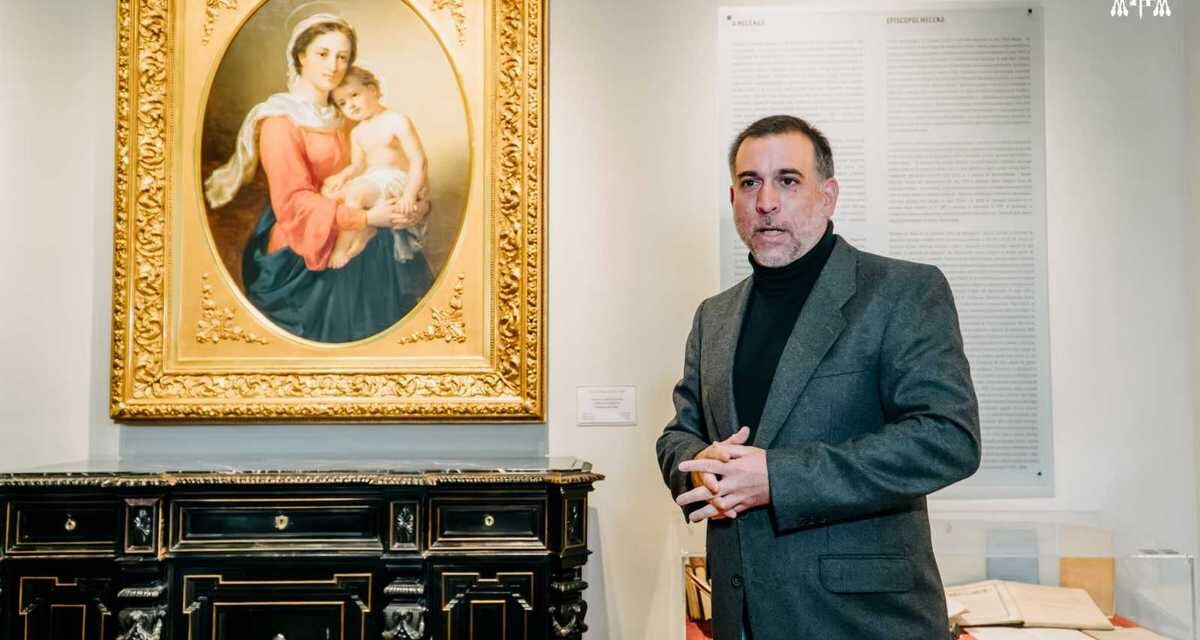OSZK employees are working to preserve the treasures of Nagyvárad.
"Times change, but healthy teaching is eternal. (...) Let us not only be guardians, but also transmitters of what our predecessors created," said László Böcskei, Roman Catholic county bishop, on Thursday in the episcopal palace in Nagyvárad, when the digitization of Lőrinc Schlauch's teachings and an agreement were announced in the company of the delegation of the National Széchényi Library and invited guests. signed for the restoration of the Szentjobb relic in Budapest.
During the event held in the Schlauch memorial hall of the bishop's palace, it was said that Lőrinc Schlauch was born in Új-Arad 200 years ago, on March 27; the name of the only cardinal of the Roman Catholic Church reigning from Nagyvárad may sound familiar to many. He left a deep mark on history, and his teachings are still relevant today.
The memorial hall in the palace was inaugurated last year, as the cardinal's sideline descendants expanded the church's collection with a significant bequest. It was then that the idea was formulated that the memory of the outstanding church politician, head of church, and theologian should be cared for in a modern and timely manner, and therefore his abundant printed literary heritage was digitized by the National Széchényi Library and made public in the Hungarian Electronic Library (MEK).
County Bishop László Böcskei emphasized that digitization provides an even wider opportunity to get to know the holy sermons. In his opinion, Lőrinc Schlauch's ideas are modern. "By reading it, we can discover many topics that still concern people today. Whether you live in mass Hungary or scattered, you face old or new realities. Hints, teachings on how to try to stand up," he explained. The head of the church emphasized that although times change, healthy teaching is eternal. "It's good to pay attention, follow and learn from it, so that we can be not only guardians, but also transmitters of what our predecessors created," he said.
Dávid Rózsa, director of the National Széchényi Library, emphasized that the mission that connects the bishopric and the Hungarian national library is the collection, preservation, processing and passing on of Transylvanian Hungarian Christian culture. "The National Széchény Library is the library of all Hungarians, it thinks in the collections of all Hungarians, so it is quite natural for us to pay special attention to the aspect of Nagyvárad," he said. He announced that more than 40 volumes have already been made available and free to download on the MEK website. According to their authors Lőrinc Schlauch and Dávid Rózsa, all documents without exception are thought-provoking reading. He added that the other great work of his life is that of Vincé Bunyitay, who was a contemporary of Schlauch Lőrincz, himself a prominent church figure and historian. His works are also available in the MEK, and at the same time, they are constantly working on the digitization and addition of other books and magazines related to Varad.
The Szentjobb relic is being restored
During the event, László Böcskei and Dávid Rózsa also signed the partnership agreement regarding the restoration of the Szentjobb relic in Budapest. This is one of the most important works of art of the Roman Catholic Diocese of Nagyvárad, owned by the Catholic community of Szentjobb. It was already mentioned in the press invitation that the small painted depiction of St. Right, connected to the person of Queen Maria Theresa, was made for the silk scarf that covered St. Stephen's right when he returned from Ragusa to Hungary in 1771, at the request of the king. The Roman Catholic Church, for this very reason, regards an artifact with the autograph relic-authentication and donor text of the queen as a touchable relic.
László Böcskei emphasized that in the renovated bishop's palace, they strive not only to preserve the "traces", but also to pass them on. "There are traces that cannot be repeated. (…) For us, the Szentjobb relic cannot be repeated. This trace belongs to our history, which we not only want to preserve, but also to make sure that it does not lose its value and can be displayed for a long time," he said.
Dávid Rózsa also emphasized that this Szentjobb relic is a special decoration of the bishopric's collection. As a first step, the restoration specialists of the library assessed the condition of the relic on Wednesday, and in the next step, they will try to restore it to the best possible condition using the best available technology.
An extremely valuable piece
Attila Lakatos, head of the bishopric's church art collection , told Maszol His story is exciting, he said. It is common knowledge that the arm relic of Saint István, which we usually call Szentjobb, was kept in a Benedictine monastery in Bihar county, in the settlement that we know today as Szentjobb. It drifted away in the Middle Ages, reappeared in Ragusa in the sixteenth century, and in 1771, by order of Queen Mária Theresia, it was returned to the territory of Hungary, in Buda. "A less well-known part of the story is that the delegation that went to Ragusa for the relic on behalf of Queen Maria Theresa made a detour on the way home to Schönbrunn, where the then elderly Maria Teresa lived. This relic was presented to him, and the silk shroud with which it was covered was presented to him as a token gift. We know Szentjobob as it is presented. And Mária Terézia makes or made - there is still a little debate about this - a drawing on this silk shroud of how she saw the Saint at that time, and she even makes an autographed relic certificate for it. And he presented this to Archabbot Dániel Somogyi, who led the delegation. He later gave it as a gift to the abbot of Szentjobb, and that's how it became the property of the diocese," explained Attila Lakatos.
He emphasized that this is a double relic, an extremely special piece. On the other hand, it is not yet possible to know exactly what the restoration will entail, as the experts must first assess its condition. "What we can already see is that for 200 years no one has really touched this. (…) The autograph section is almost threatened with destruction. It has serious contamination, so its restoration is definitely justified," he explained.
He emphasized that this is also happening as part of a wide-ranging partnership through which the Schlauch legacy has been digitized. In this regard, he pointed out that the name of Lőrinc Schlauch became well-known primarily in connection with the material works associated with his name, few people know how much of a "spiritual giant" he was. "He was one of the great pillars of Hungarian theological thinking in the 19th century. This can only be known today from his published writings, which are not in public circulation or easily accessible. This entire material has been digitized. There will be similar projects in the future. (...) The point is that as many written and printed sources relating to this region and this diocese as possible should become a public resource," said Attila Lakatos.
Source: maszol.ro
Cover photo: Attila Lakatos | Photo: Facebook page of the Roman Catholic Diocese of Nagyvárad













